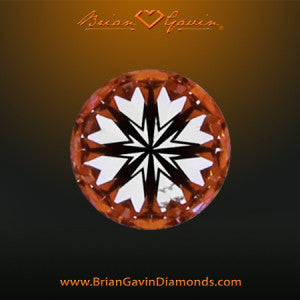
How detailed should a jewelry appraisal be?
“A close friend of mine just lost her diamond engagement ring, and her insurance company is trying to replace with a non-branded diamond, which does not seem to be the same cut quality as her original diamond, which was hearts and arrows. The problem seems to be that the appraisal issued by the original jeweler, who is no longer in business, did not reference the proportions of the diamond, or the presence of the hearts and arrows pattern, the appraisal merely states the diamond shape, carat weight, color, clarity, and the insurance value. I realize that very little can probably be done about my friend’s situation, but I’d like to avoid this type of thing personally, thus I’m wondering how detailed a jewelry appraisal should be.
The value of the Brian Gavin diamond brand:
One of the advantages to buying a Brian Gavin Signature diamond, is that it is a brand of diamond that is widely recognized for it’s quality and value, and if the brand name of the diamond is properly declared on the insurance policy, then your insurance company must base the replacement value, based upon a Brian Gavin Signature diamond of the same characteristics, provided that the insurance policy that you purchase provides coverage up to the current value of the diamond.
An example of a well written jewelry appraisal:
If we submitted this 1.394 carat, I-color, SI-2 clarity, Brian Gavin Signature round diamond for appraisal, we would expect the description to read something like this:
“One ladies platinum and diamond halo style engagement ring weighing 4.5 grams, and containing as a center stone (1) Brian Gavin Signature hearts and arrows round brilliant ideal cut diamond, graded by the American Gem Society Laboratory (AGSL) weighing 1.394 carats, which is SI-2 in clarity, and I-color with negligible fluorescence, measuring 7.15 – 7.17 x 4.42 millimeters, with a total depth of 61.7% and a table diameter of 56.9% with a crown angle of 34.3 degrees, and a pavilion angle of 40.9 degrees, with a thin to slightly thick, faceted girdle, and a pointed culet.
The AGS Laboratory determined that the overall cut grade of the diamond is AGS Ideal-0, based upon individual grades of AGS Ideal for polish, symmetry, proportions, and light performance. The girdle edge of the diamond is inscribed with the Brian Gavin Signature diamond logo, and is inscribed with AGSL 104074500019 which correlates with the diamond quality document number issued by the AGS Laboratory for this diamond; the lab report was issued on March 15, 2015.
 The diamond exhibits a crisp and complete pattern of hearts and arrows, as pictured, and exhibits a high degree of optical symmetry when viewed through an ASET Scope and Ideal Scope, as pictured. The halo style setting was designed by Brian Gavin, and contains (46) round cut diamonds weighing approximately 0.75 carats, which are F-G in color, and VS in clarity, which are pave set. Weight of accents as stated on sale receipt provided by Brian Gavin, approximate diamond weight verified by formula”
The diamond exhibits a crisp and complete pattern of hearts and arrows, as pictured, and exhibits a high degree of optical symmetry when viewed through an ASET Scope and Ideal Scope, as pictured. The halo style setting was designed by Brian Gavin, and contains (46) round cut diamonds weighing approximately 0.75 carats, which are F-G in color, and VS in clarity, which are pave set. Weight of accents as stated on sale receipt provided by Brian Gavin, approximate diamond weight verified by formula”
Actual Purchase Price = $0.00
Estimated Retail Value = $0.00
Note that this is merely an example of what we feel provides an accurate description of a Brian Gavin Signature diamond and engagement ring for insurance purposes, but this is not a definitive statement of how a proper jewelry appraisal must be written, consult with a qualified independent appraiser to learn more, and note that some independent jewelry appraisals are more detailed than others, this is just an example…
The gram weight of the ring is simply estimated for the purpose of this example, and the number of accent diamonds in the setting will vary due to the size of the center stone, this is not intended to be a description of the ring provided for sale purposes.
Helpful tips for insurance replacement of jewelry:
It is important to realize that the majority of insurance companies will not keep physical copies of the jewelry appraisal, sales receipt, or diamond grading report that you provide them with at the time you purchase your jewelry insurance policy, thus it is extremely important that you maintain copies of all documents related to your purchase, so that you may provide them for your insurance company in the event of loss.
Most insurance companies will paraphrase the description provided above as an example of what we feel represents an in-depth description of a diamond engagement ring, to a simple sentence, such as “one ladies platinum, halo style engagement ring weighing 4.5 grams, containing (1) RBCD weighing 1.39 carats, I-color, SI-2 clarity, graded by the AGSL; accent diamonds = 0.46 carats, F-G color, VS clarity.”
And in the event of loss, this might be all that an insurance adjuster, and their jewelry replacement company have to go on, if you do not have copies of your original sales receipt, jewelry appraisal, and diamond grading report to provide them with, and this is likely the cause of the problem that your friend is currently experiencing.
In addition to maintaining hard copies of the documents related to your purchase, it is a good idea to keep digital photographs of your jewelry, and store copies of the photographs and documents on a cloud drive, where they can be accessed easily, and provide you with a back-up of sorts in the event that the hard copies are damaged or can not be found.
















